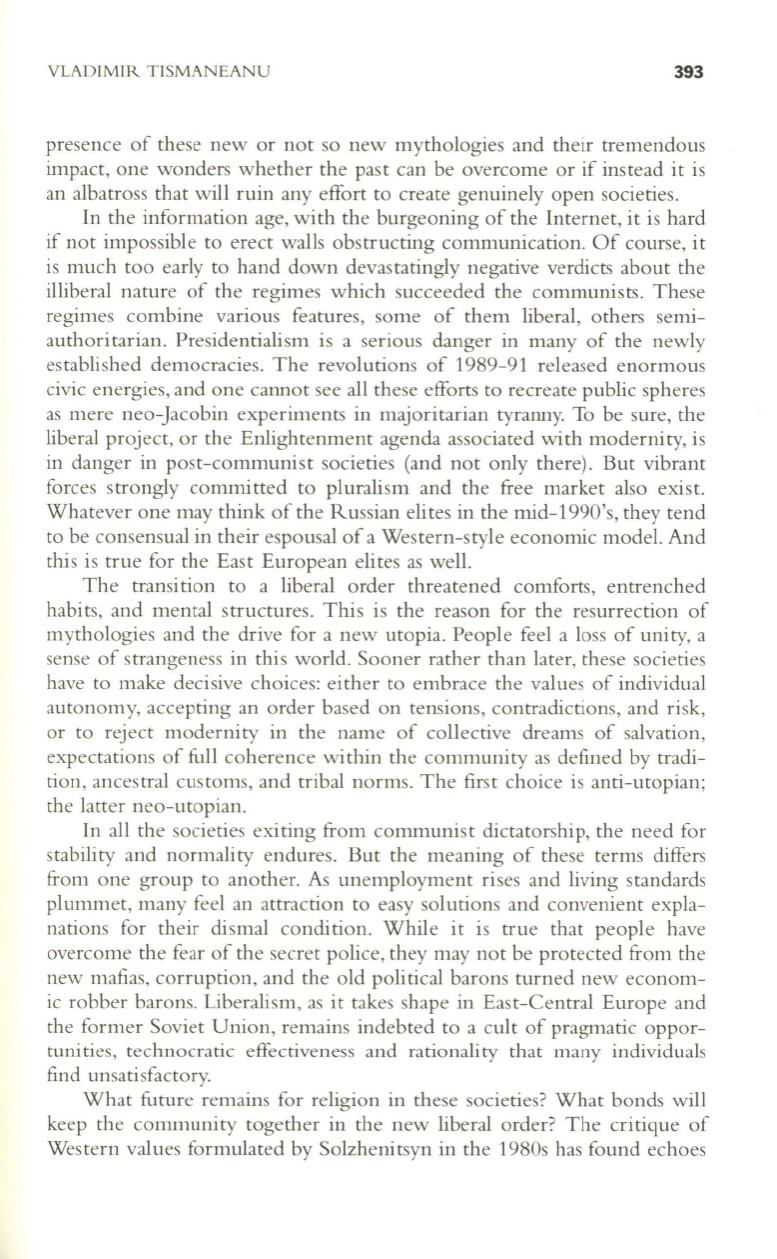
VLADIMIR TISMANEANU
393
presence of these new or not so new mythologies and their tremendous
impact, one wonders whether the past can be overcome or if instead it is
an albatross that will ruin any effort to create genuinely open societies.
In the information age, with the burgeoning of the Internet, it is hard
if not impossible to erect walls obstructing communication. Of course, it
is much too early to hand down devastatingly negative verdicts about the
illiberal nature of the regimes which succeeded the communists. These
regimes combine various features, some of them liberal, others semi–
authoritarian. Presidentialism is a serious danger in many of the newly
established democracies. The revolutions of 1989-91 released enormous
civic energies, and one cannot see all these efforts to recreate public spheres
as mere neo-Jacobin experiments in majoritarian tyranny. To be sure, the
liberal project, or the Enlightenment agenda associated with modernity, is
in danger in post-communist societies (and not only there). But vibrant
forces strongly comm.itted to pluralism and the free market also exist.
Whatever one may think of the Russian eli tes in the mid-1990's, they tend
to be consensual in their espousal of a Western-style economic model. And
this is true for the East European elites as well.
The transi tion to a liberal order threatened comforts, entrenched
habits, and mental structures. This is the reason for the resurrection of
mythologies and the drive for a new utopia. People feel a loss of unity, a
sense of strangeness in this world. Sooner rather than later, these societies
have to make decisive choices: either to embrace the values of individual
autonomy, accepting an order based on tensions, contradictions, and risk,
or to reject modernity in the name of collective dreams of salvation,
expectations of full coherence within the community as defined by tradi–
tion, ancestral customs, and tribal norms. The first choice is anti-utopian;
the latter neo-utopian.
In all the societies exiting from communist dictatorship, the need for
stability and normality endures. But the meaning of these terms differs
from one group to another. As unemployment rises and living standards
plummet, many feel an attraction to easy solutions and convenient expla–
nations for their dismal condition. While it is true that people have
overcome the fear of the secret police, they may not be protected from the
new mafias, corruption, and the old poli tical barons turned new econom–
ic robber barons. Liberalism, as it takes shape in East-Central Europe and
the former Soviet Union, remains indebted to a cult of pragmatic oppor–
tuni ties, technocratic effectiveness and rationali ty that many individuals
find unsatisfactory.
What future remains for religion in these societies? What bonds will
keep the community together in the new liberal order? The critique of
Western values formulated by Solzhenitsyn in the 1980s has found echoes


